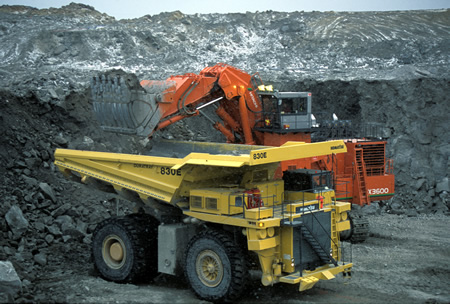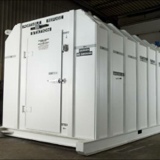Information
-
Document No.
-
Audit Title
-
Client / Site
-
Conducted on
-
Prepared by
-
Location
-
Personnel
EQUIPMENT COMPLIANCE AUDIT
-
1.1.2 - Absence of Code Requirements regarding Pressure Vessels
-
1.1.2
Notwithstanding the absence of a specific code requirement, all work shall be carried out without undue risk to the health or safety of any person. -
4.4.2 - Moving Parts & Machinery
-
4.4.2 Unless situated so as to prevent a person coming into accidental contact with it, every drive belt, chain, rope or pulley, sprocket, flywheel, geared wheel and every opening through which any belt, pulley or wheel operates, and every bolt, key, set screw and every part of any wheel or other revolving part that projects unevenly from the surface shall be effectively enclosed, covered, or guarded.
-
4.4.9 Lifting Devices
-
4.4.9
(1) A lifting device shall be designed, constructed and installed in accordance with recognized standards and good engineering practice, provided with overwind protection if power operated, and provided with an identification plate.
(2) The maximum load that a lifting device may carry shall be established by its designer.
(3) A notice showing the maximum established load shall be posted in a location visible to the operator and, except during testing, it shall not be exceeded.
(4) Each component that may affect the safe operation of a lifting device shall be examined and tested by a qualified person before initial use and thereafter at intervals not exceeding one year, and a record shall be kept showing the dates, findings and names of the qualified persons performing the examinations and tests and the record shall be kept available for inspection.
(5) Where a combination of lifting devices is used simultaneously, the work shall be supervised by a qualified person. -
4.5.3 - Guard Rails
-
4.5.3
Elevating work platforms and all similar aerial platforms shall have
(1) standard guardrails on all open sides or be enclosed to provide equivalent protection (toe-boards may be omitted at the access openings),
(2) guards to protect the occupants from the elevating machinery, and
(3) signs clearly indicating the safe maximum working load. -
4.5.4 - Non-Destructive Testing
-
4.5.4
All vehicle mounted aerial devices and self-propelled boom-type elevating work platforms shall have critical components non-destructively tested by a qualified person prior to their introduction to a minesite, and at intervals not to exceed 12 months -
4.5.7 - Logbook - Elevated Work Platform
-
4.5.7
A logbook shall be maintained for each vehicle mounted aerial device and self-propelled boom-type elevating platform in which any defect, operating difficulty, inspection, test, maintenance, modification and repair work is to be recorded. All entries shall be dated and signed by the person responsible for the work. -
4.9.1 - Backup Alarm
-
4.9.1
(1) The manager shall ensure that every unit of rubber tired mobile equipment in regular use at a mine in excess of 7000 kg gross vehicle weight is equipped with a "back-up" alarm which meets the requirements of SAE J-1446 and SAE J-994. Underground mobile equipment designed for bi-directional use shall be excluded from this requirement.
(2) The alarm shall be clearly audible above the background noise at the workplace and it shall continue as long as the equipment is moving in reverse.
(3) Mobile equipment operating in a mine may use a visual back-up alarm in place of an audible back-up alarm providing that the visual back-up alarm complies with the following criteria:
(a) the light shall be clearly visible above the usualdaily light levels,
(b) actuation of the alarm shall be completelyindependent of the operator, and
(c) the light shall flash as long as the vehicletransmission is in the reverse position -
4.9.2 - Transmission Interlock
-
4.9.2
Every unit of mobile equipment having a fluid drive transmission shall be equipped with an interlocking system to prevent the unit from being started and put into motion unless the transmission selector is returned through the neutral position. -
4.9.3 - Fire Extinguisher
-
Every vehicle shall carry at least one fire extinguisher of adequate size and of the proper type.
-
4.9.4 - Vehicle Requirements
-
4.9.4
(1) All rubber tired mobile equipment over 7000 kg gross vehicle weight shall have a minimum of two wheel chocks which shall be used whenever necessary.
(2) All mobile equipment shall have
(a) a firmly secured seat for the operator and any authorized passenger, well maintained in a comfortable, shock absorbing condition,
(b) approved safety seat belts,
(c) suitable clearance lights and reflectors, and
(d) if an operator cab was provided as part of the original equipment package, or subsequently fitted, windshields, side and rear windows, and rear vision mirrors shall be maintained to provide clear visibility, and the glazing material shall meet the specifications of ANSI Standard Z26.1 - 1990 "Safety Glazing Materials for Glazing Motor Vehicles.” -
4.9.5 - Vehicle Requirements 2
-
4.9.5
A vehicle, other than a vehicle used directly for production in an operating open pit, shall, additional to that equipment required for highway driving, be equipped with
(1) a whip antenna that is fitted with a flag and lamp high enough to be visible to the drivers of all
production vehicles, or
(2) a flashing light mounted above the cab of the vehicle. -
4.9.6 - Fire Suppression for Underground Equipment
-
4.9.6
(1) All mobile equipment capable of containing more than 25 L of flammable fluids and used in underground mines shall be fitted with a manually activated multi-nozzle fire suppression system. Manual activation of the system shall be possible from each side of the machine and at the operator's station.
(2) Actuation of the fire suppression system shall also cause engine shutdown.
(3) Electric hydraulic diamond drills shall be equipped with
(a) a deflector shield between the hydraulic pump and the motor, and
(b) a temperature probe in the hydraulic oil, which will shut down the drill if oil temperature reaches 65 degrees Celsius. -
4.9.8 - Personnel Carriers and Hazardous Materials
-
4.9.8
(1) Every personnel carrier shall be inspected each day by an authorized person before being used to transport persons, and if any defects are found which could affect the safe operation of the vehicle they shall be corrected before it is used.
(2) Where it is necessary to transport hazardous materials on a personnel carrier at the same time as persons, the materials shall be in an isolated compartment, adequately ventilated and drained, and accessible only from outside of the vehicle. If the compartment is inside the vehicle, it shall be separated from the passenger section by an approved firewall. -
4.9.9 - Data Plate
-
4.9.9
(1) No truck or loader shall be operated within a mine unless there is affixed to the inside of the cab, at a place clearly visible to the operator, a nameplate of the vehicle manufacturer showing the serial number and maximum rated load capacity of the vehicle.
(2) Where a truck, scraper or any other rubber tired vehicle, has a gross vehicle weight in excess of 45,000 kg, the name plate referred to in subsection (1) shall
also show the maximum allowable speeds at the rated gross vehicle weight that the retarder and/or braking system is designed to accommodate when traveling on
(a) the maximum downgrade on which the vehicle is designed to operate, and
(b) not less than 2 other specified slopes between such maximum downgrade slope and level ground. -
4.9.10 - Braking and Steering Modifications
-
4.9.10
Every truck, loader or other rubber tired vehicle having a manufacturer's gross vehicle weight in excess of 45,000 kg shall have any modification affecting the braking, steering or resulting in an increase to the gross vehicle weight be approved by the chief inspector. -
4.9.11 - Rollover Protection Structures
-
4.9.11
(1) A loader, grader, scraper, tractor, compactor roller, skidder, rough terrain fork lift, bulldozer, and offhighway haul truck introduced into service after July 1, 1991, shall be equipped with a rollover protective structure that conforms with any of the following standards
(a) Society of Automotive Engineers, Standard SAE-J1040 April 1988 "Performance Criteria for Rollover Protective Structures (ROPS) ForConstruction, Earthmoving, Forestry and
Mining Machines,"
(b) "Earthmoving Machinery Rollover Protective Structures -- Laboratory Tests and Performance Requirements ISO 3471, or (c) Canadian Standards Association, Standard
B352.095 "Rollover Protective Structures (ROPS) for Agricultural, Construction, Earthmoving, Forestry, Industrial, and Mining Machines."
(2) Where the mobile equipment referred to in subsection (1) is designed mainly for underground use,
(a) a ROPS designed by a professional engineer shall conform to Clause 6 of CSA B352-M1980 but does not require physical testing, or Falling Object Protective Structures (FOPS)
(b) a FOPS (Falling Object Protective Structures) canopy may be substituted for a ROPS canopy provided it is specifically approved by the chief inspector. -
4.9.12 - Rops & Fops Identification and Seatbelt Use
-
4.9.12
(1) The following information shall be permanently marked on rollover protective structures
(a) the name and address of the manufacturer or the registered professional engineer who certified the ROPS,
(b) the model and serial number,
(c) the make, model, and series of the machine for which the rollover protective structure is designed, and
(d) where the ROPS has been designed and constructed in accordance with section 4.9.11 (2), the notation "Underground Use Only" shall be added.
(2) Seat belts of a type conforming with the recommended Practice of the Society of Automotive Engineers SAE-J-386 "Operator Restraint Systems forOff-Road Work Machines" shall be installed in all mobile equipment fitted with a rollover protective structure and the operator of the equipment shall wear the seat belt when operating the equipment -
4.9.13 - Rops & Fops Modifications
-
4.9.13
(1) No addition, modification, welding or cutting of a ROPS shall be permitted except in accordance with the instructions of a registered professional engineer and all modified ROPS shall be permanently marked to show the modifications made, the date of recertification and the name and address of the certifying engineer.
(2) A registered professional engineer may re-certify a damaged, deformed or deteriorated ROPS, after repairs have been made, if he is satisfied that the structural integrity has not been impaired.
(3) ROPS shall be designed and fitted so as not to restrict the operator's field of vision -
4.9.15 - Securing of Equipment
-
4.9.15
(1) Trucks with dump boxes shall be equipped with a permanently attached device for securing or locking the box in a raised position, or carry suitable equipment on board for this purpose.
(2) No person shall place himself beneath the raised box of a dump truck, bulldozer blade, scraper blade, loader bucket or similar equipment unless it is securely and adequately blocked or otherwise secured independently of the normal operating controls -
4.9.16 - Brakes
-
4.9.16
(1) Mobile equipment must have braking systems meeting the requirements of the following applicable standard, or other standard acceptable to the chief inspector:
(a) Society of Automotive Engineers (SAE) Standard J/ISO3450 JAN 98, Earthmoving Machinery–Braking Systems of Rubber-Tired Machines–Systems and Performance
Requirements and Test Procedures;
(b) Society of Automotive Engineers (SAE) Standard J1026 APR 90, Braking Performance– Crawler Tractors and Crawler Loaders;
(c) Society of Automotive Engineers (SAE) Standard J1472 JUN 87, Braking Performance– Roller Compactors;
(d) ANSI Standard ANSI/ASME B56.6-1992, Safety Standard for Rough Terrain Forklift Trucks;
(e) ANSI Standard ASME B56.1-1993, Safety Standard for Low Lift and High Lift Trucks.
(2) When required by the inspector, an independent means of retardation shall be provided in addition to the requirements of subsection (1). -
4.9.17 - Parking Brake
-
4.9.17
Every motor vehicle shall be equipped with an effective, mechanically activated parking brake, the holding power of which is not affected by loss of fluid or air pressure from the braking system -
4.9.18 - Common Components
-
4.9.18
On any vehicle where components that apply the service brakes and the emergency brakes are common, the components shall be arranged so that a failure in a common component does not reduce the capability of one of the systems to stop the vehicle safely -
4.9.19 - Annual Brake Testing
-
4.9.19
(1) Trucks having a manufacturer's rated gross vehicle weight in excess of 45,000 kg shall be subjected to downgrade braking tests such that at least once a year
50% of the fleet is tested, and every truck in the fleet is tested at intervals not exceeding 3 years. The tests shall be as follows:
(a) the vehicle shall be loaded to the manufacturer's maximum permissible gross vehicle weight,
(b) the tests shall be conducted on a well-graded hard packed downgrade slope of uniform grade of between 8% and 10% or where there is no downgrade slope satisfying this condition, tests shall be conducted on the maximum downgrade slope over which the trucks are operated,
(c) auxiliary retarding devices shall not be used during the brake tests, and
(d) stopping distances shall be measured from the initial point of application of the service brakes to the final stopping position, from an initial speed of 40 km/h, and the minimum acceptable brake performance shall be as follows:
Initial Speed 40 km/h
Grade Stopping Distance
10% 84 m
9% 76 m
8% 68 m
(2) Where a vehicle fails to meet the minimum brake performance standards specified under subsection (1)
(d), it shall be removed from service until corrective measures have been taken and the vehicle meets the standard. -
4.9.20 - Auxiliary Steering
-
4.9.20
(1) If wheeled mobile equipment having rated speed capability exceeding 20 km/h depends on engine power for steering and power failure will prevent the vehicle from being steered manually, a supplementary system shall be provided to enable the operator to steer to a controlled stop.
(2) The supplementary steering system required by subsection (1) shall meet the requirements of Society of Automotive Engineers (SAE) Standard J1511 ISO5010 FEB 94, Steering For Off-Road, Rubber- Tired Machines.
(3) When hydraulic accumulators are used to provide power to supplemental steering systems, they shall depressurize when the engine is deliberately shut down. -
4.9.21 - Automatic Engine Shutdown
-
4.9.21
Where automatic engine shutdown devices are employed on vehicles, audible and visual alarms shall be installed in the operator's cab to pre-warn the operator that an automatic engine shutdown is imminent. -
4.11.2 - Power to be Cut Off - Lockout
-
4.11.2
(1) Before any work is performed on electrical equipment, the main power source shall be disconnected, locked-out and tagged.(2) Where equipment to be worked on is powered by a source other than electricity, the power supply shall be shut off, locked-out and tagged. A means shall be provided to safely release the stored energy from the equipment before any work begins. If a valve in a pipe could leak and allow water, steam, compressed air or other potentially hazardous substance to reach persons working on the equipment, the pipe shall be blanked off, or otherwise isolated, in accordance with the lockout procedure. -
6.19.2 - Logbook To Be Maintained
-
6.19.2
The manager shall provide and maintain an effective logbook system for each unit of mobile equipment over 7000 kg gross vehicle weight where
(a) the vehicle operator notes the operating condition prior to operating of the vehicle
(b) note any unsafe conditions, and
(c) a qualified person making repairs, notes any repairs made and if the vehicle is safe to operate









